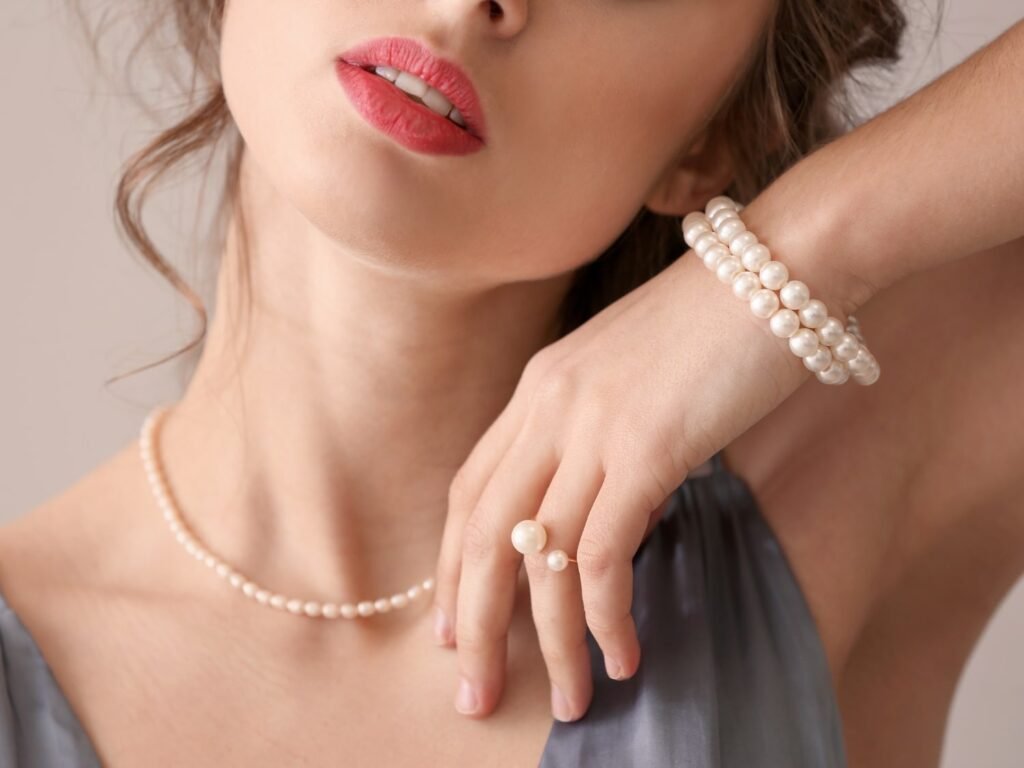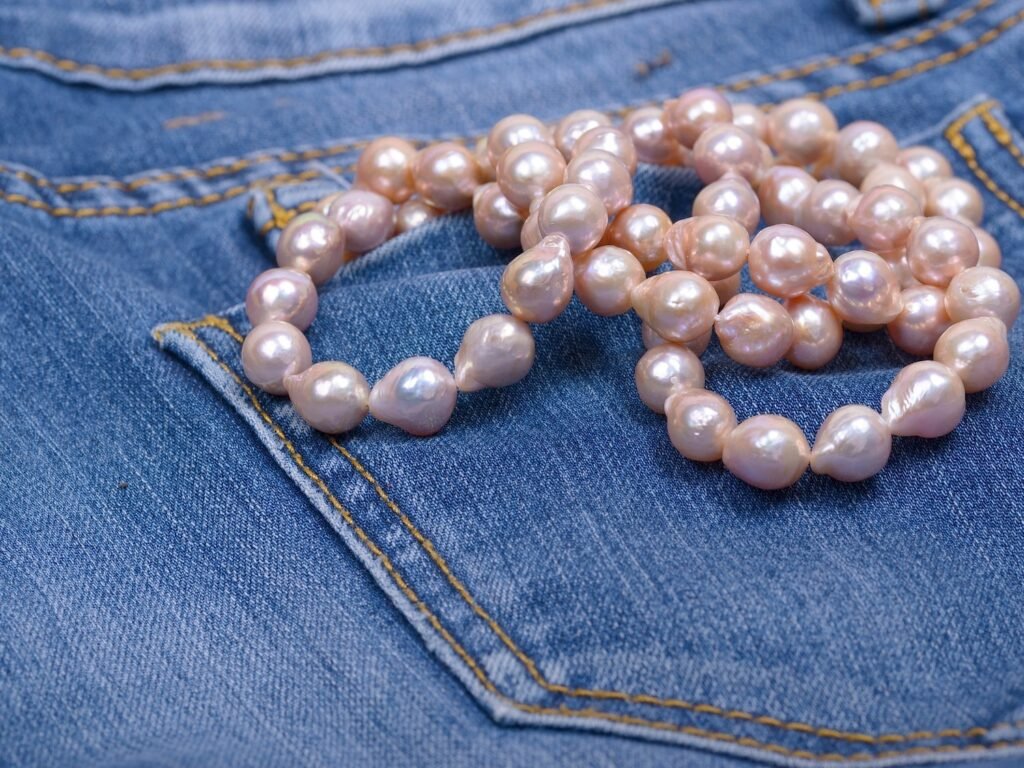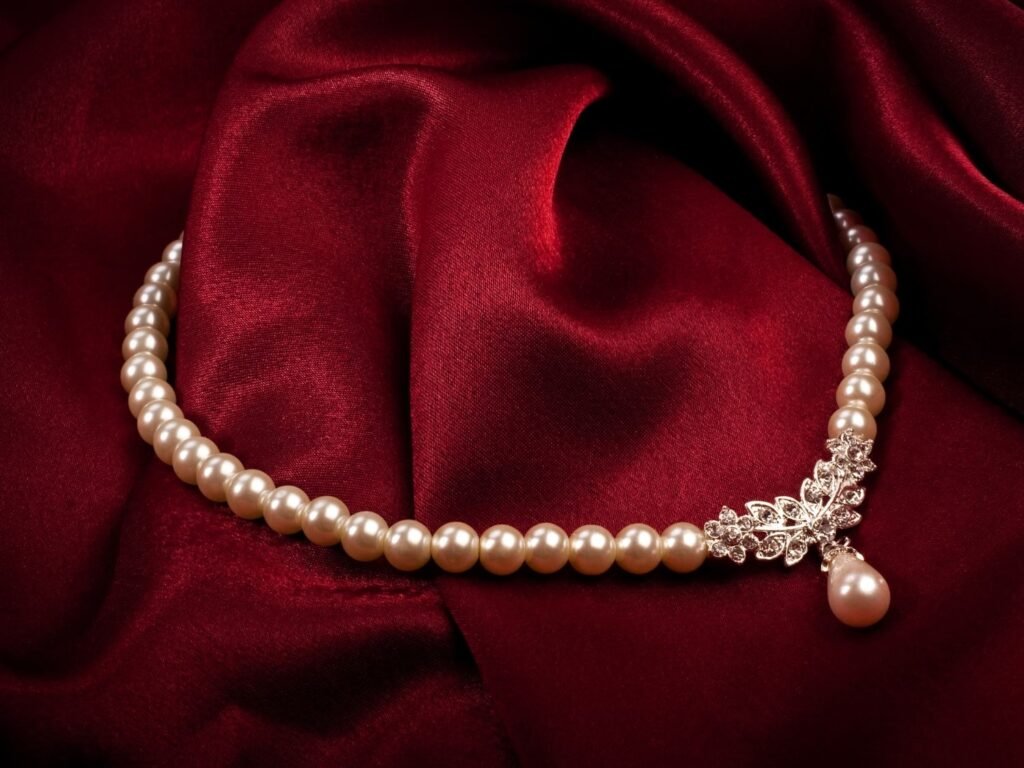
Pearl jewellery, with its timeless elegance and natural beauty, has been cherished for centuries. Whether it’s a classic strand of white pearls or a modern design featuring colored freshwater pearls, caring for your pearl jewellery is essential to preserving its luster, longevity, and value. Unlike harder gemstones, pearls are organic and delicate, making them susceptible to damage from everyday exposure to chemicals, humidity, and even improper storage. In this comprehensive guide, we’ll explore the best practices for cleaning, wearing, storing, and maintaining your pearl jewellery so it remains as radiant as the day you received it.
Why Pearls Require Special Care?
Pearls are formed inside mollusks, primarily oysters and mussels, as a natural defense against irritants. Their composition is primarily calcium carbonate (in the form of aragonite) bound together by conchiolin, a natural protein. This organic nature gives pearls their softness—typically around 2.5 to 4.5 on the Mohs scale—making them much more delicate than diamonds, rubies, or even gold.
Because of their porous structure, pearls can easily absorb oils, chemicals, and moisture. They are also sensitive to acidic environments, high temperatures, and physical abrasions. This means pearl jewellery demands a gentler approach to care than most other fine jewellery.
1. How to Clean Pearl Jewellery Properly
Cleaning pearls is not like polishing a diamond or wiping down a metal chain. Here’s how to do it the right way:
Step-by-Step Cleaning:
Wipe After Every Wear
After wearing your pearl jewellery, gently wipe it with a soft, lint-free cloth (preferably microfiber or flannel). This helps remove body oils, sweat, perfume, or makeup residue that may have accumulated.
Occasional Deep Cleaning
If your pearls need a more thorough cleaning:
- Prepare a bowl of lukewarm water with a drop of mild, non-detergent soap (like baby shampoo).
- Dip a soft cloth into the solution and gently wipe the pearls.
- Never soak pearl jewellery, especially those strung on silk, as prolonged water exposure can weaken the thread.
- Rinse the cloth with clean water and wipe the pearls again to remove soap residue.
- Lay flat to dry on a towel. Ensure the string is completely dry before storing.
Things to Avoid when cleaning Pearls
- Never use ultrasonic cleaners or steamers.
- Avoid commercial jewellery cleaners unless they specifically state they are safe for pearls.
- Don’t scrub pearls or use toothbrushes, abrasive pads, or any rough materials.
2. How to Wear Pearl Jewellery Safely?

Wear Your Pearl Jewellery Last
Pearls are delicate, organic gems that require extra care when being worn. A helpful rule of thumb is to follow the philosophy of “last on, first off.” This means your pearl jewellery should be the final touch you add after getting dressed and the first thing you remove at the end of the day. Doing so minimizes exposure to chemicals, moisture, and physical contact that could compromise the beauty and integrity of your pearls.
One of the most important precautions is to apply all beauty and grooming products before putting on your pearl jewellery. Items like perfumes, lotions, hairsprays, and cosmetics often contain alcohol, acids, and other chemicals that can strip away the natural luster of pearls. Since pearls are porous, they easily absorb substances from their environment, which can cause discoloration, dullness, or long-term damage. Letting these products dry fully before adorning your pearls helps prevent residue buildup and keeps their surface radiant and smooth.
Avoid Sweat and Water
It’s also essential to avoid exposing pearls to water or excessive sweat. Never wear them while swimming in chlorinated pools, relaxing in hot tubs, or taking a shower, as the chemicals and minerals in water—especially chlorine and salt—can erode the nacre (the outer layer of the pearl) over time. Similarly, wearing pearls during exercise or outdoor activities where sweating is inevitable should be avoided. Sweat contains natural acids and salts that can slowly degrade the pearl’s surface and weaken the string, especially if left uncleaned.
Prevent Contact with Hard Surfaces
Lastly, be mindful of what your pearls may come into contact with during wear. Avoid pairing pearl jewellery with rough or heavily textured fabrics such as wool or sequins, which could scratch the pearls or wear down their surface finish. Be cautious about wearing pearls during physically demanding tasks like housework, gardening, or even lifting heavy bags, as accidental knocks or abrasions can chip, crack, or flatten the nacre. The goal is to protect your pearls from any hard surfaces, friction, or impact that could affect their natural beauty.
3. How to Store Pearl Jewellery Correctly

Proper storage is essential to preserving the natural beauty, shape, and strength of pearl jewellery. Because pearls are softer and more delicate than most other gemstones, the way they are stored can significantly impact their longevity. Improper storage can lead to scratches, discolouration, cracking, or even thread breakage. To keep your pearls in pristine condition, it’s important to understand and follow best practices for storage.
Store Pearls Softly and Separately
Pearls should always be stored separately from other jewellery to prevent damage. Unlike diamonds or harder stones, pearls can easily be scratched if they rub against metal parts or gemstones. To avoid this, place each piece of pearl jewellery in a soft cloth pouch, a velvet-lined jewellery box, or a compartmentalized case that keeps it from touching other items. You can also wrap your pearl necklace or bracelet in a clean, soft cloth before placing it in a drawer or jewellery case. This simple practice helps preserve their smooth surface and ensures they remain free from nicks and abrasions.
Avoid Airtight and Plastic Containers
Pearls are organic and respond to their environment. They require a slight amount of natural humidity in the air to retain their structure and luster. Storing pearls in airtight containers, plastic bags, or sealed boxes can trap dry air, causing the pearls to dehydrate and become brittle over time. It’s best to store them in breathable materials that allow a gentle exchange of air—such as fabric pouches or boxes made specifically for pearls. This allows them to “breathe” and helps prevent them from cracking or developing a chalky surface.
Lay Flat If Pearls Are Strung
For pearl jewellery that is strung on silk or thread, such as necklaces and bracelets, always store the pieces flat. Hanging these items—especially for long periods—places stress on the thread, which may stretch, weaken, or even break over time. Laying them flat supports the natural shape and integrity of the strand, preventing uneven tension and helping maintain the piece’s original design and comfort when worn. Choose a storage tray or drawer where the piece can rest without bending or being compressed.
Mistakes to Avoid When Storing Pearls
There are several common storage mistakes that can lead to damage. One major mistake is hanging pearl necklaces. Although it may seem like a convenient way to prevent tangling, hanging puts pressure on the silk thread, which can stretch it out and make the necklace sag or break. It’s always safer to lay them flat and secure them in place.
Another frequent error is storing pearls with other types of jewellery, particularly those made of harder materials like diamonds, sapphires, or metal chains. These can scratch the delicate nacre of the pearls and cause irreversible damage. To preserve your pearls’ smoothness and shine, store them in a separate compartment or use individual pouches.
4. Restringing Pearl Necklaces and Bracelets
Over time, the string holding your pearl jewellery together can wear out, stretch, or become discolored. Regular restringing ensures your pearls remain secure and well-aligned.
How Often Should You Restring?
- For frequently worn pieces: once every 1 to 2 years.
- For rarely worn pieces: once every 3 to 5 years.
Opt for a professional jeweller who uses silk or nylon thread and ties knots between each pearl. Knotting helps prevent the pearls from rubbing against each other and ensures that if the strand breaks, only one pearl falls off instead of many.
5. Periodic Maintenance and Checks
Just like any investment, pearl jewellery benefits from regular checkups.
What to Look For:
- Loose Pearls: Gently check if any pearl in your earrings or rings is wobbly.
- Worn Clasp: Make sure clasps are secure, especially for vintage or heirloom pieces.
- Frayed String: If the thread looks fuzzy or discolored, it’s time for restringing.
Taking your jewellery to a professional jeweller annually for inspection ensures small issues don’t become major losses.
6. Travelling with Pearl Jewellery
When travelling with pearl jewellery, special care is needed to avoid damage in transit.
Travel Tips:
- Use a dedicated jewellery pouch or travel case with padded compartments.
- Wrap each item individually in soft cloth.
- Avoid packing pearls with toiletries or inside checked luggage where they may be crushed.
7. How to Revive Dull Pearls
If your pearls have lost their luster due to age or improper storage, there are a few ways to bring them back to life—though results may vary depending on damage.
Gentle Revival Tips:
- Wipe with a damp cloth regularly to rehydrate.
- Let them breathe: keep them in open-air storage occasionally.
- For major dulling or surface wear, consult a jeweller for professional polishing or surface treatment options.
However, always manage expectations—some damage, like acid etching or deep abrasions, is irreversible.
Buying High-Quality Pearls for Long-Term Beauty

When it comes to long-term care and enjoyment, quality matters. Choosing high-grade, well-matched pearls from a trusted jeweller gives you a better foundation for maintenance. Look for:
- Good nacre thickness (for luster and durability)
- Even shape and color
- Knotted strings for safety
- 925 silver or gold clasps for longevity and value
If you’re shopping for pearl jewellery in Singapore, our store offers a wide range of customizable freshwater pearl necklaces and bracelets. Each piece is crafted with care, using only top-grade pearls, and fitted with 925 sterling silver clasps for elegance and durability. Our customizable options also allow you to choose your preferred pearl size, bracelet or necklace length, and gift packaging—making them perfect for personal wear or special occasions.
Caring for Pearls FAQ
How to make pearls last longer?
To make pearls last longer, it’s essential to handle them with care by following a few key practices: always put on pearl jewellery after applying makeup, perfume, or hairspray to avoid exposure to harsh chemicals; clean them gently with a soft cloth after each wear to remove oils and residue; store them separately in a soft pouch or fabric-lined box to prevent scratches; and avoid exposing them to water, sweat, or extreme heat. Additionally, for pearl necklaces or bracelets, have them restrung every one to two years, especially if worn frequently, to ensure the string remains strong and secure.
Can a pearl ring be worn every day?
While a pearl ring can be worn every day, it requires extra care due to the delicate nature of pearls. Pearls are much softer than other gemstones and can be easily scratched, chipped, or dulled by exposure to chemicals, water, or rough surfaces. If you choose to wear a pearl ring daily, it’s best to avoid activities like cleaning, cooking, exercising, or using hand sanitizers while wearing it. Regular cleaning with a soft cloth and safe storage when not in use will help maintain its beauty, but for long-term preservation, occasional wear is generally recommended over daily use.
Can I shower with pearl jewelry?
No, you should not shower with pearl jewelry. Pearls are highly sensitive to water, soap, shampoo, and other bath products, which can damage their delicate nacre and cause them to lose their natural luster over time. The moisture can also weaken the silk or thread used in pearl necklaces and bracelets, increasing the risk of breakage. To protect the beauty and longevity of your pearls, always remove them before showering or exposing them to water.
How long does pearl jewellery last?
With proper care, pearl jewelry can last for generations, often 50 years or more, depending on how frequently it is worn and how well it is maintained. Because pearls are organic and softer than most gemstones, they require gentle handling, regular cleaning, and appropriate storage to preserve their luster and integrity. Avoiding exposure to harsh chemicals, water, and abrasive materials significantly extends their lifespan. Additionally, pearl necklaces and bracelets should be restrung every one to two years to prevent thread deterioration, especially if worn regularly.
Do pearls deteriorate if not worn?
Yes, pearls can deteriorate if not worn for extended periods. Pearls are organic gems that benefit from the natural moisture in the air and even from the oils in your skin, which help maintain their luster and prevent drying out. When stored away for too long, especially in airtight or overly dry conditions, pearls can become brittle, lose their shine, or develop surface cracks. To keep them in good condition, it’s recommended to wear your pearls occasionally and store them in a breathable, fabric-lined box or pouch that allows some airflow.
Final Thoughts
Pearl jewellery is more than an accessory—it’s a symbol of grace, refinement, and tradition. With the right care and maintenance, your pearls can maintain their natural radiance and become a treasured part of your jewellery collection for generations. Remember the key pillars of pearl care: gentle cleaning, cautious wearing, proper storage, and periodic maintenance. Treat your pearls with love, and they will reward you with a lifetime of beauty.

